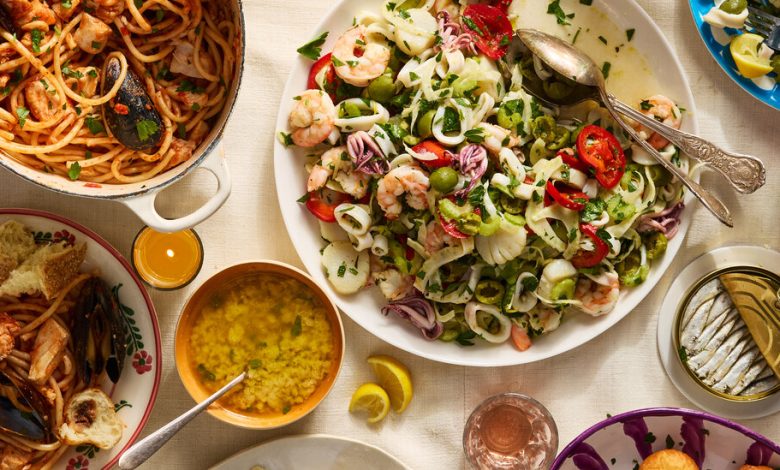Seven Fishes (Not Seven Dishes) for Christmas Eve

A marinara-stained kitchen timer ticks as Donna Berzatto choreographs a complex dance of dishes around limited oven space. “I need you to remember to put the Rockefellers in, and take out the artichokes, which leaves an open oven,” she commands her son Carmy. “I need you to put the branzino on the top and let it broil and get that nice little crispy bit.”
The alarm buzzes again and again and again, a metaphor for the ticking time bomb of family drama brewing during preparations for the Christmas Eve tradition of the Feast of the Seven Fishes. The scenes of the high-intensity cooking feat, from the latest season of the popular television series “The Bear,” delivered an emotionally heightened portrayal of a tradition dear to many Italian American families. The 67 anxiety-inducing minutes probably didn’t inspire anyone to tackle the celebratory meal.
This is unfortunate because the food is amazing, and the kitchen drama is part of what makes it all worth it. As an Italian American who grew up with the feast, I recognized the truth behind the dramatization in “The Bear”: The meal is often more about the cooking than it is about the eating. As any family who has attempted to prepare it knows, the essence of the Feast of the Seven Fishes is the preparation’s mess, which are inherent to the celebration.
Some believe you have to suffer for the food to taste good (hi, Donna!), while others embrace the chaos and imbue it with laughter and cheer. “For my dad, being in the kitchen is the holiday,” said Francesco Sedita, a co-author of the children’s picture book “Our Italian Christmas Eve.”
In Italy, the traditional Christmas Eve dinner is known as La Vigilia, or the eve. Rooted in Roman Catholicism, which calls for abstaining from meat on the eve of any holiday, La Vigilia tends to be a bounty of seafood. The Feast of the Seven Fishes is uniquely American. Italian immigrants created their own traditions and identities, and likely used the number seven because of its biblical significance.
The feast is typically made up of at least seven dishes, each containing its own type of fish, separated into various courses. There are no strict rules, and no specific fish are required. Every family takes deep pride in their own unique way of orchestrating the feast.
For modern feasts, what remains important is keeping the tradition alive out of respect for the aunts, uncles and grandparents who have prepared the meal for years. The complex menu has evolved, though, to keep the heart of the feast beating.
“Seven fishes for a dinner, realistically, could possibly be a heavy lift for people,” said the Italian American chef Christian Petroni.
One way to bring the feast to the table without making it a stressful or dramatic undertaking is to prepare seven fishes, but not seven dishes. The menu below does that by including an easy, crowd-pleasing crisp and zesty cold seafood salad that contains three types of seafood. Buttery stuffed clams can be baked then kept warm until it’s time to serve, and anchovy-stuffed dough balls can be formed and fried ahead of time.
For the finale, a saucy and celebratory pasta catches the remaining fish — but it could be the only dish you serve if that’s all you have time to do. If that’s the case, pop open tins of briny anchovies, sardines or mussels for an effortless way to make it to seven fishes.
Each year, as my family works away in the kitchen, we brag about having spent the week before maniacally sourcing seafood from several different fish markets in town, as if there is a badge of honor to be earned for each stop. We laugh as the older generations playfully frighten the children with the more exotic sea creatures. My aunt frantically asks who can bring an extra pot for the pasta, as if she doesn’t have the same urgent revelation every year. There are somehow never enough pots.
As Mr. Sedita said, it’s not only about the food but also “the dedication to time spent together. We are in it for the long haul — the laughing, the crying, the yelling.” Ultimately, what we are really feasting on is emotions, which, hopefully, bring on more smiles and less agita than anything on the table.
Recipe: Zeppole con le Alici (Fried Anchovy Balls)

Squeezing lemon juice over the balls just before serving give them a tangy freshness.Credit…Ryan Liebe for The New York Times. Food Stylist: Barrett Washburne. Prop Stylist: Paige Hicks.
Each bite of these dough rounds begins with a perfectly crisp exterior that gives way to a yeasty, pillowy interior. Once you hit the fish at the center, you are in briny ecstasy. These are as delicious at room temperature as they are hot, so you can fry them ahead of time.
Recipe: Insalata di Frutti di Mare (Italian Seafood Salad)
This version of the classic Italian dish uses shrimp, scallops and calamari, but works well with any seafood you can get your hands on. Prepare it a day ahead of time to give the seafood even more time to soak up the lemony, garlicky dressing.
Recipe: Clams Oreganata (Baked Stuffed Clams)
In this take on the beloved Italian American classic, butter crackers are used in place of plain bread crumbs to add their fatty saltiness to the crunchy topping, which coats juicy whole clams. A buttery wine sauce is spooned over the clams just before eating.
Recipe: Mussels and Cod Bucatini With Spicy Tomato Sauce
Simple yet celebratory, this hearty seafood pasta is a party dish that your guests will want to tuck into. White wine-steamed mussels and tomato-poached cod top a mound of bucatini coated in a buttery, brothy sauce.
Follow New York Times Cooking on Instagram, Facebook, YouTube, TikTok and Pinterest. Get regular updates from New York Times Cooking, with recipe suggestions, cooking tips and shopping advice.
